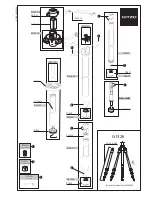
Start-up
Bit number
Simple description
Bit pattern
31
Any error
0x80000000
–
Healthy
0x00000000
The bit pattern may be different if there is more than one error.
For example, if the status code is 80000005, the user must convert
the hexadecimal number to a binary number.
Hex
8
0
0
0
0
0
0
5
Binary
1000 0000 0000 0000 0000 0000 0000 0101
The binary number has a total of 32 bits. The least significant bit is
located at the right end of the following table.
"1" means that the bit is switched on. "0" means that the bit is
switched off.
Binary
number
1
0
0
0
0
00 0000
0000 0000
0000 00
0
0
0
1
0
1
Bit
position
31 30 29 28 27
26 to 6
5
4
3
2
1
0
So in this example, bits 0, 2 and 31 are switched on. According to
the previous table, the sensor has the status codes "temperature",
"measuring device error" and "any error".
Command: "bias"
The "bias" command reports the current bias status of the sensor.
Secondary bias commands: "on", "off", "[values]".
The secondary commands allow the user to turn the bias function
on and off. Switching the function on sets the force/torque output
to 0. Switching the function off clears the bias bit. In addition, the
user can preload the sensor with user-defined values.
Command: "peak"
The "peak" command reports the highest and lowest force/torque
values that have occurred for a runtime and for all of the times.
The peak reset command resets only the runtime peaks.
All time peaks are the largest values observed while the sensor
was on and operating. When the sensor is turned on, the sensor
records the peak values detected on each individual axis. If the
sensor detects all-time peak values that are higher than the
factory settings, the sensor has been loaded beyond the intended
calibrated detection range.
Command: "saveall"
The "saveall" command stores all values that are retained after a
power failure in the NVM.
23
01.00 | FTR-AXIA | Commissioning instructions | en | 1517835
Summary of Contents for FTR-AXIA
Page 39: ......
















































